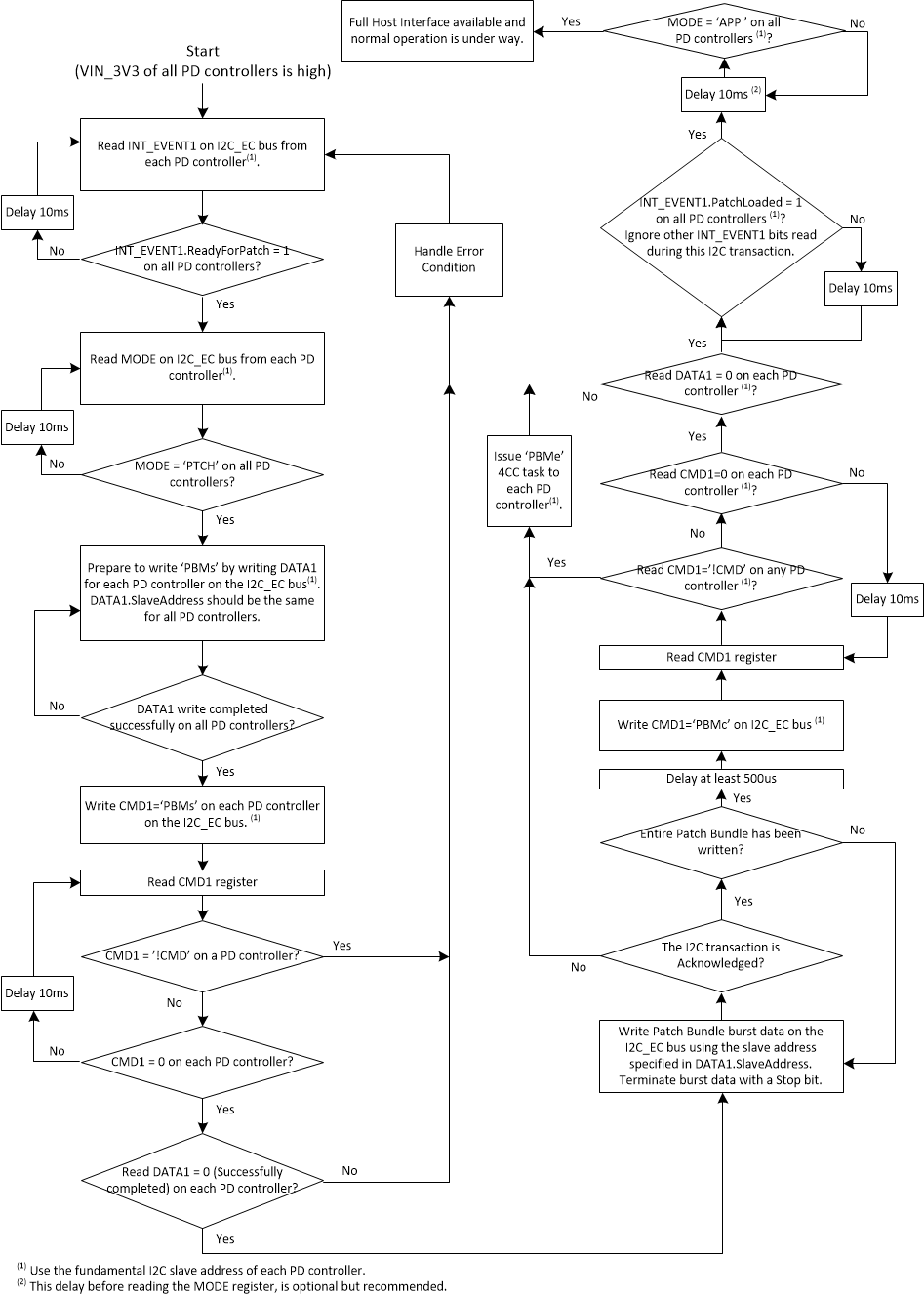SLVUC05A November 2020 – July 2022 TPS25750
- Read This First
- 1Introduction
-
2Unique Address Interface Register Detailed Descriptions
- 2.1 0x03 MODE Register
- 2.2 0x0D DEVICE_CAPABILITIES Register
- 2.3 0x14 - 0x19 INT_EVENT, INT_MASK, INT_CLEAR Registers
- 2.4 0x1A STATUS Register
- 2.5 0x26 POWER_PATH_STATUS Register
- 2.6 0x29 PORT_CONTROL Register
- 2.7 0x2D BOOT_STATUS Register
- 2.8 0x30 RX_SOURCE_CAPS Register
- 2.9 0x31 RX_SINK_CAPS Register
- 2.10 0x32 TX_SOURCE_CAPS Register
- 2.11 0x33 TX_SINK_CAPS Register
- 2.12 0x34 ACTIVE_CONTRACT_PDO Register
- 2.13 0x35 ACTIVE_CONTRACT_RDO Register
- 2.14 0x3F POWER_STATUS Register
- 2.15 0x40 PD_STATUS Register
- 2.16 GPIO Events
- 2.17 0x69 TYPEC_STATE Register
- 2.18 0x70 SLEEP_CONFIG Register
- 2.19 0x72 GPIO_STATUS Register
- 34CC Task Detailed Descriptions
- 4User Reference
- 5Revision History
4.2 Loading a Patch Bundle
The patch bundle may contain Application Customization data and a Patch binary that modifies the default application firmware in the PD controller. This section describes how the host can load the patch bundle. The host uses the I2Cs bus for all transactions related to loading the patch bundle. As noted in the flow diagram below, the I2C slave address varies depending upon which mode the PD controller is in. The Patch Burst Mode allows the host to push the Patch Bundle to multiple PD controllers simultaneously.
The following flow diagram illustrates the normal successful patch loading process. Other error handling steps may be necessary depending upon the nature of the errors encountered for a particular system. The EC may reset and restart the patch process by issuing a 'PBMe' 4CC Task.
| MODE register read-back value | I2Cs |
|---|---|
| Slave Address #1 | |
| 'BOOT' | As configured by ADCINx pins for Port A. This is the "Fundamental" I2C slave address. |
| 'PTCH'(1) | |
| 'APP '(2) |
 Figure 4-1 Flow for Pushing a Patch Bundle Over the I2Cs Bus to Multiple PD Controllers at the Same
Time
Figure 4-1 Flow for Pushing a Patch Bundle Over the I2Cs Bus to Multiple PD Controllers at the Same
TimeWhile the host is writing the Patch Bundle burst data, the I2C protocol in the following figure must be followed. The host may send the entire Patch Bundle in a single I2C transaction, or it may break it up into multiple transactions. The PD controller increments the pointer into its patch memory space with each byte received on the Patch Slave address that was configured by DATA1.SlaveAddress as part of the 'PBMs' 4CC Task. The EC may re-issue a 'PBMs' 4CC Task or it may issue a 'PBMe' 4CC Task to reset the pointer.
 Figure 4-2 Protocol of Patch Bundle Burst Data Assuming
it is Broken into Two Transactions
Figure 4-2 Protocol of Patch Bundle Burst Data Assuming
it is Broken into Two Transactions